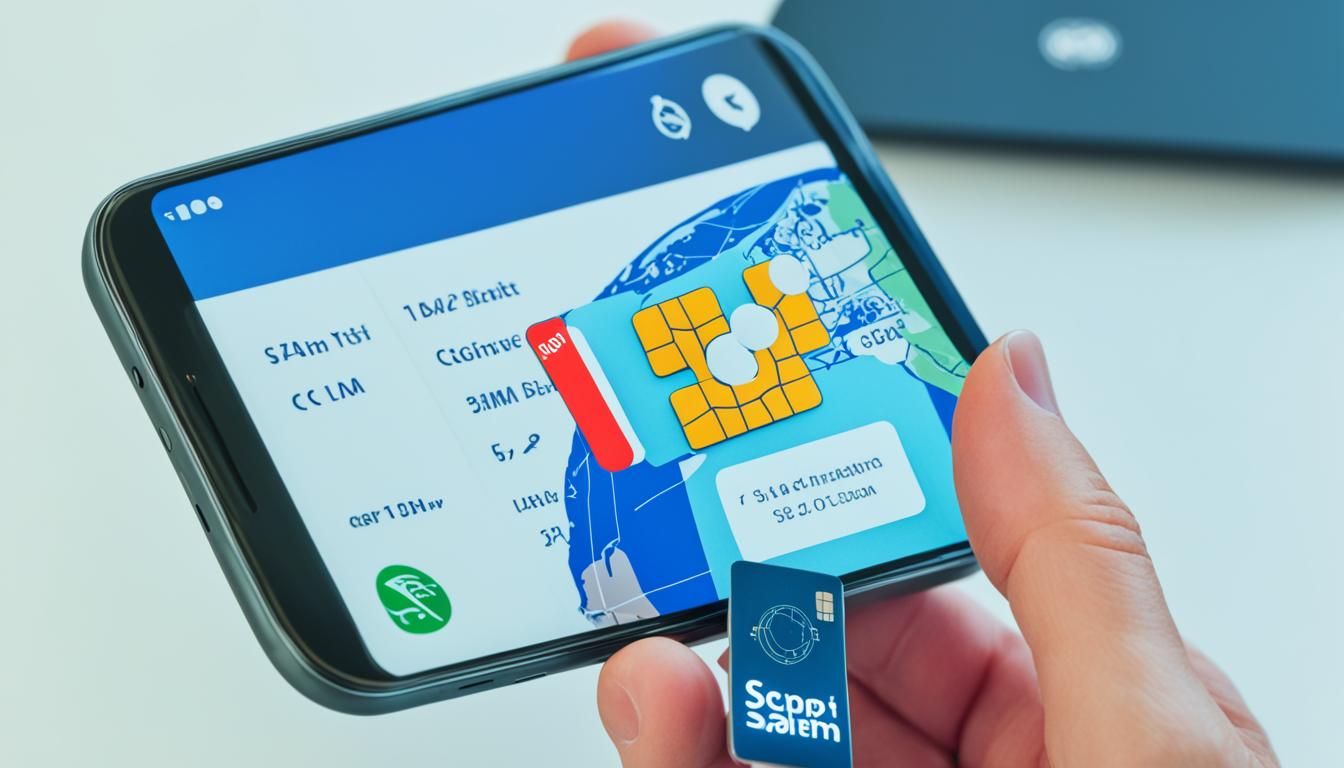
Are you tired of expensive roaming charges while traveling abroad? Do you want to stay connected without breaking the bank? Look no further than a travel SIM card. But what exactly is a travel SIM card and how can it benefit you? In this article, we will delve into the world of travel SIM cards, explore their advantages, and provide valuable tips for finding the best one for your needs.
Key Takeaways:
- Travel SIM cards provide a cost-efficient solution for staying connected while abroad.
- They offer affordable rates for calls, texts, and data, saving up to 90% on roaming charges.
- Travel SIM cards provide flexibility, global coverage, and the convenience of a local number.
- Options such as local SIM cards, eSIM cards, and international plans are also worth considering.
- Managing data usage and downloading essential information before your trip can further enhance your connectivity experience.
Benefits of Using a Travel SIM Card
When traveling abroad, staying connected is essential. One cost-efficient option that offers flexibility, affordability, and convenience is using a travel SIM card. These cards allow travelers to access local cellular networks, providing affordable rates for calls, texts, and data. Here are some key benefits of using a travel SIM card:
- Cost-efficient: Using a travel SIM card can save up to 90% on roaming charges compared to regular mobile carriers. This means significant savings on your phone bills while traveling internationally.
- Global coverage: Travel SIM cards work in multiple countries, making them an ideal choice for travelers visiting various destinations. You won’t have to worry about changing SIM cards or dealing with different carriers in each country.
- Convenience of having a local number: With a travel SIM card, you’ll be assigned a local number in the country you’re visiting. Having a local number makes it easier to stay connected with local contacts, book accommodations, and make local calls without incurring high charges.
- Positive reviews: Many travelers have shared positive reviews about their experiences with travel SIM cards. They have found them to be reliable, affordable, and effective in keeping them connected during their trips.
Using a travel SIM card ensures that you can make calls, send texts, and browse the internet without breaking the bank. It’s a convenient and cost-effective solution for staying connected while exploring new destinations.
“Travel SIM cards offer a cost-efficient and reliable way to stay connected while traveling abroad. With affordable rates and global coverage, they provide the flexibility and convenience that travelers need.”
Travel SIM Card Comparison Table
| Travel SIM Card | Benefits | Global Coverage | Positive Reviews |
|---|---|---|---|
| TravelSIM | Affordable rates, flexibility | 190+ countries | 4.5/5 |
| WorldSIM | Multi-country bundles, data rollover | 200+ countries | 4/5 |
| Keepgo | Long validity, data-only plans | 120+ countries | 4.2/5 |
| Roam Mobility | Unlimited talk and text, data plans | USA and Canada | 4.3/5 |
Based on the table above, TravelSIM and WorldSIM are popular choices among travelers due to their extensive global coverage and positive reviews. Keepgo and Roam Mobility also offer attractive features and have received favorable ratings. When selecting a travel SIM card, consider factors such as coverage, pricing, data plans, and customer reviews to find the best option for your needs.
Next, we’ll explore how travel SIM cards work and provide tips on using them effectively during your international trips.
How Does a Travel SIM Card Work?
A travel SIM card is a small, removable card that can be inserted into an unlocked smartphone or tablet. Once inserted, it allows users to access local cellular networks in the country they are visiting, just like a local resident. To use a travel SIM card, travelers need to:
- Check compatibility: Ensure that their device is compatible with the travel SIM card and unlocked to accept SIM cards from different carriers.
- Purchase the card: Buy a travel SIM card before their trip from a reputable provider, either online or from authorized retailers.
- Insert the card: Insert the travel SIM card into their device by removing the existing SIM card and replacing it with the travel SIM card.
- Activate the card: Follow the instructions provided by the travel SIM card provider to activate the card, which may involve registering online or making a phone call.
- Top up with credit or data: Depending on the card and user’s needs, travelers may need to top up their travel SIM card with credit or data, either before their trip or during their stay.
Travel SIM cards work in various countries, making them ideal for travelers visiting multiple destinations. They provide access to local networks, allowing users to make calls, send texts, and use data at local rates rather than incurring expensive roaming charges. Using a travel SIM card ensures seamless connectivity and affordability while exploring new places.
Buying a Local SIM Card
If you’re planning an extended stay or you’re looking for an affordable option to make local calls while abroad, buying a local SIM card in your destination can be a cost-effective choice. Local SIM cards are readily available at airport vendors or phone stores, providing convenient access to local networks and attractive data offers.
Depending on the country you’re visiting, buying a local SIM card can often be more economical than using international cell phone plans or travel SIM cards from other providers. It allows you to enjoy affordable rates for calls, texts, and data, tailored to your specific needs while you explore a new place.
Purchasing a local SIM card is a straightforward process. You can easily find authorized vendors in airports or dedicated phone stores near popular tourist areas. These vendors offer a variety of SIM card options, ranging from short-term plans for travelers to longer-term plans for those staying in the country for an extended period.
When buying a local SIM card, it’s essential to consider the following factors:
- Compatibility: Ensure that the local SIM card is compatible with your unlocked smartphone or tablet before making a purchase.
- Network Coverage: Research the local network providers and their coverage in the areas you plan to visit to ensure you have reliable service throughout your trip.
- Data Offers: Take advantage of attractive data offers that often come with local SIM cards, allowing you to stay connected without breaking the bank.
By buying a local SIM card, you can enjoy the convenience of a local phone number, affordable rates, and the flexibility to customize your communication needs while abroad.
Disclaimer: The image above is for illustrative purposes only and does not represent a specific SIM card brand or provider.
Utilizing an eSIM Card
eSIM cards offer a modern solution for accessing local numbers without the need for a physical SIM card. These digital SIM cards can be purchased and downloaded onto compatible smartphones, allowing travelers to connect to cell networks and access data while overseas. One of the leading providers of eSIM cards is Airalo, offering a wide range of options covering numerous countries and regions.
The process of using an eSIM involves a few simple steps. First, travelers need to download the provider’s app onto their device. Then, they can browse through the available eSIM options and make a purchase based on their specific needs and destination. Once the eSIM is selected, it can be installed onto the device and activated when ready to use.
It’s important to note that not all smartphones support eSIM technology. However, many newer models from popular brands such as Apple, Samsung, and Google have eSIM capabilities. Before purchasing an eSIM card, travelers should check their smartphone’s compatibility to ensure a seamless experience.
Using Google Fi for International Travel
When it comes to international travel, staying connected is crucial. One option that offers seamless connectivity and convenience is Google Fi, a virtual cell phone service provider that partners with local providers to offer cell, data, and text services in over 200 countries.
With Google Fi, travelers can enjoy unlimited free texting, allowing them to keep in touch with friends and family back home without worrying about international fees. Additionally, Google Fi allows users to use their phones abroad just like they do at home, making it easier to navigate unfamiliar places, find local attractions, and stay connected to essential online services.
Data costs the same when using Google Fi abroad as it does in the US, ensuring that travelers won’t be hit with unexpectedly high data charges. However, it’s important to note that phone calls made while abroad may incur an additional fee.
Overall, Google Fi is a convenient option for frequent international travelers who want reliable connectivity and the ability to use their phones seamlessly while exploring different countries. While the data prices may be higher compared to other options while in the US, the benefits of staying connected abroad can outweigh the costs.
If you’re considering using Google Fi for your international travel, it’s important to check if your current device is compatible with the service. You can check the compatibility of your device on the Google Fi website or through their app.
Why Choose Google Fi for International Travel?
- Access to cell, data, and text services in over 200 countries
- Unlimited free texting
- Use your phone abroad just like at home
- Data costs the same as in the US
- Reliable connectivity and coverage
- Convenient for frequent international travelers
“I’ve been using Google Fi for my international travels, and it’s been a game-changer. The ability to use my phone abroad without worrying about excessive fees or unreliable coverage has made my trips much more enjoyable.” – Jessica, frequent traveler
Whether you’re a frequent international traveler or simply want reliable connectivity during your trips abroad, Google Fi can be a great option. It provides the convenience of a local cell phone service provider with the added benefits of seamless international coverage and affordable rates.
Using T-Mobile and Sprint for Free Overseas Data
T-Mobile and Sprint offer budget-friendly options for staying connected while abroad. T-Mobile customers with specific plans can enjoy unlimited 2G data, as well as unlimited texting and calls at a fixed rate, in more than 210 destinations. Similarly, Sprint customers get free text messages and 2G data, with the option to purchase data packages for faster speeds. These options allow travelers to use their phones for basic data needs without incurring high costs.

Comparison of Free Data Plans
| Service Provider | Plan Benefits | Supported Destinations |
|---|---|---|
| T-Mobile | Unlimited 2G data Unlimited texting and calls |
210+ destinations |
| Sprint | Free text messages and 2G data Data packages available for faster speeds |
Global coverage |
Adding an International Plan to Your Existing Wireless Plan
If you want to use your phone number for calls and texts while overseas, adding an international plan to your existing wireless plan is a straightforward option. Major US wireless providers like Verizon offer international plans that provide unlimited talk, text, and data in specific countries or for a fixed daily rate. This allows you to use your phone just like at home, keeping your US number and having immediate access to your phone upon arrival overseas.
Benefits of Adding an International Plan:
- Unlimited talk, text, and data in specific countries
- Access to your phone number while abroad
- Immediate connectivity upon arrival overseas
Adding an international plan to your existing wireless plan eliminates the need for a separate SIM card or relying solely on Wi-Fi networks. With a seamless transition, you can stay connected with friends, family, and colleagues while traveling internationally.
“By adding an international plan to your existing wireless plan, you can enjoy the convenience of your US phone number and avoid the hassle of switching SIM cards or relying solely on Wi-Fi networks. With unlimited talk, text, and data in specific countries, you can stay connected wherever your travels take you.”
Here’s an example of a table comparing the international plans offered by major US wireless providers:
| Wireless Provider | International Plan | Coverage | Data Limit | Cost |
|---|---|---|---|---|
| Verizon | TravelPass | Multiple countries | Unlimited | $10/day |
| AT&T | International Day Pass | 100+ countries | Unlimited | $10/day |
| T-Mobile | Magenta® Plus | 210+ countries | Unlimited | $50/month |
Using Wi-Fi Only
To save on data usage, travelers can rely on Wi-Fi networks for internet access. Many public spaces, cafes, restaurants, and hotels offer free Wi-Fi access, allowing you to connect to the internet without incurring any additional charges. By putting your phone in airplane mode and connecting only to Wi-Fi networks, you can avoid international roaming fees and still stay connected to the internet for basic online activities.

When traveling abroad, it’s essential to have access to the internet for various purposes like staying in touch with family and friends, searching for directions, and browsing useful information. Utilizing Wi-Fi networks can significantly reduce your reliance on cellular data and help you stay within your data plan limits.
By connecting to free Wi-Fi networks, you can enjoy fast internet access without worrying about excess data charges. Here’s how you can make the most of Wi-Fi while traveling:
1. Research Wi-Fi Availability in Your Destination
Prior to your trip, research the availability of Wi-Fi in your destination. Many hotels, airports, cafes, and public areas offer free Wi-Fi access to their guests and visitors. Some popular smartphone apps also provide information about nearby Wi-Fi hotspots, helping you locate them easily.
2. Enable Airplane Mode and Connect to Wi-Fi
To avoid accidentally using cellular data, enable airplane mode on your device. Then, manually turn on Wi-Fi to connect to available networks. Remember to disable any automatic connection options for cellular data to ensure your phone doesn’t switch networks unintentionally.
3. Secure Wi-Fi Networks
When connecting to public Wi-Fi networks, be cautious and choose secure options whenever possible. Look for networks that require passwords or have encryption protocols in place to protect your data. Avoid accessing sensitive information or making financial transactions on unsecured networks.
4. Use Wi-Fi Calling and Messaging Apps
If you need to make calls or send messages, consider using Wi-Fi calling and messaging apps like WhatsApp, Skype, or FaceTime. These apps allow you to make voice or video calls and send messages over Wi-Fi, ensuring that you stay connected without using cellular minutes or incurring additional charges.
5. Download Maps and Entertainment in Advance
Prior to your trip, download offline maps and entertainment content, such as movies or TV shows, onto your device. This way, you can access essential navigation tools and enjoy entertainment even when there’s no Wi-Fi available. Apps like Google Maps and Netflix offer offline functionality for this purpose.
Overall, utilizing Wi-Fi networks while traveling can help you save on data usage, avoid roaming charges, and stay connected to the internet for all your essential needs. By following these tips and making the most of free Wi-Fi access, you can enjoy seamless connectivity and make your travel experience more convenient and economical.
| Advantages of Using Wi-Fi Only | Disadvantages of Using Wi-Fi Only |
|---|---|
|
|
Managing Data Usage
To avoid excessive data charges while traveling, it’s important to effectively manage your data usage. By following these tips, you can reduce data consumption and stay within your plan’s limits:
Turn Off Cellular Data When Not Needed
When you’re not actively using the internet or specific apps that require data, consider turning off cellular data to prevent unnecessary usage. This can help conserve data and avoid unexpected charges.
Restrict Background Apps
Many apps continue to consume data in the background, even when you’re not actively using them. To reduce data usage, restrict background app refresh and disable automatic app updates or downloads. This way, apps will only use data when you manually open them.
Change Email Settings
Emails with attachments or images can consume a significant amount of data. To limit automatic downloads, adjust your email settings to only download content when you’re connected to Wi-Fi. This can help minimize data usage while still allowing you to read and send emails.
Track and Monitor Data Usage
To stay informed about your data consumption, use third-party apps or your phone’s built-in features to track and monitor your data usage. These tools can provide insights into which apps or activities are using the most data, allowing you to make informed decisions and adjust your usage accordingly.
“To avoid excessive data charges while traveling, it’s important to effectively manage your data usage.”
By implementing these strategies, you can actively reduce data usage and avoid unexpected charges while traveling. Taking proactive steps to manage your data consumption ensures that you can stay connected without breaking the bank.
Downloading Before You Go
To avoid relying on internet access while traveling, it’s advisable to download essential apps, maps, guides, and entertainment before you go. This ensures that you have access to important information even when you don’t have an internet connection. By downloading offline maps and other resources, you can navigate, find local attractions, and access useful information without relying on Wi-Fi or mobile data.
Before embarking on your journey, take the time to download the following:
- Offline Maps: Download maps of your destination to have access to navigation even when there’s no internet connection. Applications like Google Maps and Maps.me allow you to download specific areas or entire regions, ensuring you’ll never get lost.
- Language Translation Apps: If you’re traveling to a country where you’re unfamiliar with the language, download a translation app like Google Translate or iTranslate. These apps can help you with basic communication and understanding signs or menus.
- Travel Guides: Many popular travel guide apps, such as Lonely Planet and TripAdvisor, offer offline access to their content. Download the guides for your destination of choice to get comprehensive information about attractions, restaurants, and local tips.
- Entertainment: Long flights or train rides can be more enjoyable with downloaded movies, TV shows, or podcasts. Popular streaming platforms like Netflix and Spotify allow you to download content in advance, so you can stay entertained without an internet connection.
By preparing in advance and downloading these essential resources, you’ll be well-equipped for your travels and can rely on the information and entertainment you’ve stored on your device.
Remember, once you’ve downloaded these apps and resources, make sure to keep them updated before your trip to ensure you have the latest information and features.
To illustrate the importance of downloading maps before you go, here’s a visual representation of the difference it can make:
Conclusion
When traveling abroad, staying connected is crucial for many travelers. Thankfully, there are several options available to keep you connected at affordable rates. Travel SIM cards, local SIM cards, eSIM cards, and international plans offer flexibility and convenience.
Choosing the right option depends on factors such as your mobile service provider, destination, and data needs. By following the tips provided in this article, you can make an informed decision and enjoy seamless connectivity while traveling abroad.
Remember to check with your mobile provider for specific details and consider factors such as costs, coverage, and compatibility. With the right choice for your needs, you can stay connected and make the most of your travel experiences without worrying about outrageous roaming charges.


